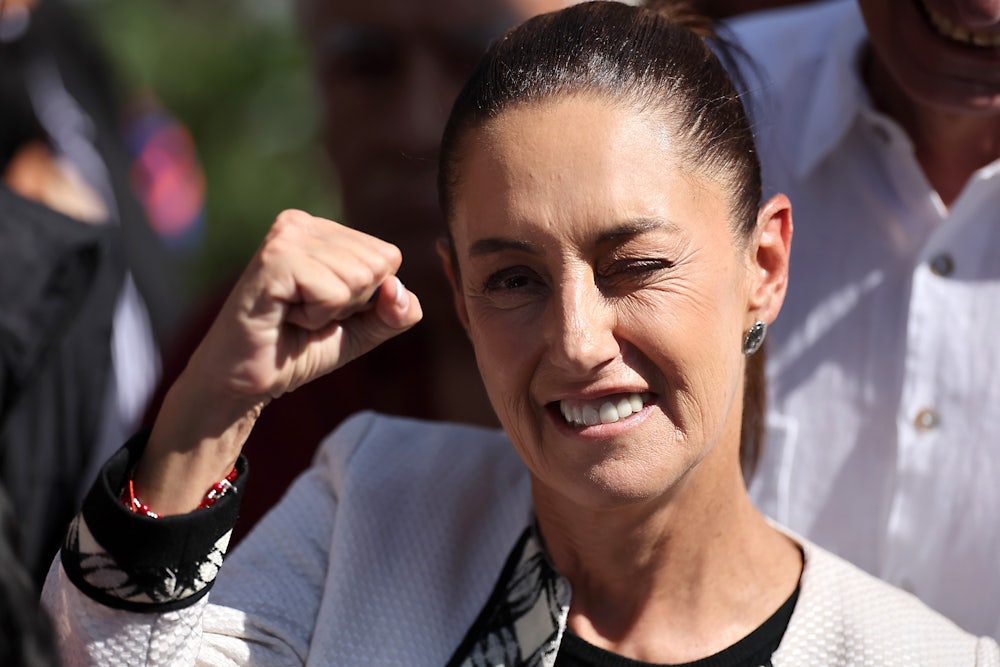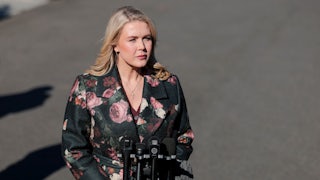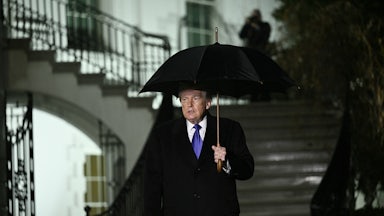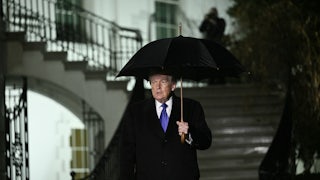It was another day of record-breaking heat across Mexico.
With our daughters, I had accompanied my wife, Jovi, to her polling station,
where she’d cast her vote for climate scientist and former mayor of Mexico City
Claudia Sheinbaum to become the country’s first woman president. Back home, I turned
on the television, and there was Sheinbaum’s rival, Xóchitl Gálvez, from the
conservative PAN party, candidate of the opposition PAN-PRI-PRD coalition known
as PRIAN, exultantly claiming victory and calling on President Andrés Manuel
Lopéz Obrador—universally known as AMLO—to meet with her to discuss the
transfer of power. Among those rejoicing onstage were various familiar politicians
from those final two decades when their now-allied parties had dominated
Mexican politics, until 2018, the year that the leftist populist AMLO rode
widespread repudiation of those parties and their governments into the
presidency. The notoriously corrupt outgoing president, Enrique Peña Nieto of
the PRI, had a 12 percent approval rating. It had been AMLO’s third try for the
presidency. Along with the party he’d founded, Morena, AMLO would launch the
governing project known as the 4T, the Fourth Transformation in Mexican
political history.
“Jovi, pay attention, this looks serious!” I urgently shouted, standing in front of the television in our living room, but Jovi, unfazed, in the vestibule, kept up her cheerful conversation with our friend Levi, who’d come to stay with us from the States for a few days. Was Xóchitl Gálvez’s celebration a ruse to set the stage for a contesting of the election, as has become the Trump-inspired fashion among Latin American right-wing parties? For the next few hours, she and her supporters repeated her claims. But news commentators reported that exit polls and early returns forecast a landslide. Shortly after midnight, the official results were announced. Sheinbaum had won 59 percent of the vote to Gálvez’s 28 percent. She’d collected more votes than any Mexican candidate in history, surpassing her predecessor and mentor, AMLO, in total votes by some four million.
It was a resounding affirmation of the AMLO presidency and of the 4T. But was voter satisfaction with the current status quo enough, I wondered, to explain what had drawn so many voters to wait hours in long lines under a punishing sun? The historic chance to vote for a woman president surely inspired many. Anger or fear, of course, always reliably brings people out. But fear of what? There was no obvious reason for fear of Mexico’s relentless plagues of narco violence and disappearances to drive voters to either candidate, since neither had proposed credible solutions to those problems—really, who would dare? It had already been an exceptionally violent election, with at least 34 candidates slain, among them 14 from Morena, compared to three from the PRI and four from the PRD (though none from PAN). If there was fear, I thought, it was of the past. It was, among other things, a landslide vote for not going back to how things were before, when the political establishment, the PRI, followed in 2000 by the PAN, ruled Mexico, always at the service of business elites and interests, Mexican and foreign, and of politicians who regarded political power as a means to corrupt self-enrichment.
Had AMLO truly put the interests of the poor at the center of government, or was it just rhetoric? And if so, had he succeeded without, as the entrepreneurial class endlessly warned—even as the economy prospered—ruining that economy?
I thought back to an extraordinary conversation—one that opened my eyes to sometimes difficult truths about AMLO’s presidency—that I’d had about a year ago with Santiago Aguirre, the director of the Centro ProDH human rights organization that provides legal representation to the families of the 43 Ayotzinapa teaching school male students disappeared in 2014. In the city of Iguala, Guerrero, the youths had been kidnapped from buses that, in keeping with their college’s tradition, they’d hired to transport students to Mexico City for the annual protest in memory of the 1968 Tlatelolco student massacre, but they had been violently attacked and kidnapped by police and a heroin trafficking group, and were never seen alive again. Though the remains of three students have been identified by DNA testing, the whereabouts of the others remains a mystery.
In Mexico, that crime, which had triggered massive protest marches throughout the country, had come to represent the collusion between narco groups and every level of the Mexican state. To some degree, Ayotzinapa had made AMLO’s election possible, and he came to power promising to solve the crime. Progress was made, but starting in 2022, as the Justice Department’s young special prosecutor and a U.N.-associated team of international investigators came closer to exposing the roles of the Mexican military, including elite Navy Marines, at the heart of the crime and its cover-up, AMLO had purposefully stalled the case, driving that prosecutor and then international investigators from the country. That AMLO has ceded so much power to the military during his sexenio, or six-year term, is one of the main criticisms of his presidency. Aguirre and the Centro ProDH, along with other legal representatives of the victims’ families, and some journalists, became targets of the president’s invective; also of illegal surveillance via Israeli Pegasus spyware. AMLO, Aguirre told me, had caused “irreparable damage” to the case. We lapsed into a glum silence. Finally, I said, “So is that it, then, for AMLO and the 4T? Is there anything about the 4T you’d want to preserve?”
“There is,” Aguirre said firmly. “In our spheres we’re preoccupied by certain themes, the militarization, torture, disappearances, the rule of law. But outside of that is a whole country that has been ruptured by inequality, and this government has put that problem at the center of governance, until now primarily in a symbolic way, but also with some measures that aren’t at all insignificant. The doubling of the minimum wage. Expanding social security to include domestic employees. The rise in social expenditures and the streamlining of their bureaucratic spending. Discussions about skin color as a cause of racism that didn’t occur in public before.”
Aguirre’s words of selfless clarity and vision astonished me.
“But that said,” he went on, “in our terms of justice, security, rule of law, this government’s performance has been very lamentable, and doesn’t get a passing grade.… But how would this country be now if it had been governed by Ricardo Anaya [AMLO’s PAN opponent in the last election]? I don’t even want to imagine it.”
In her June 3 column in Spanish newspaper El País, Viri Ríos, a young Harvard Ph.D. Mexican economist and political analyst who grew up working class in one of Mexico City’s roughest barrios, wrote, “I am very moved. I see the results and think of the 5.1 million people who rose out of poverty in the sexenio, the 3.6 million workers who for the first time were able to purchase la canasta básica, basic foodstuffs, and the 800,000 minimum-wage workers who doubled their weekly earnings. I think of them because that’s the only way to understand what we are today living.”
AMLO’s presidency was far from perfect, as Ríos in her writings always emphasizes. “Not everything was gained. Some would say very little was gained. But the truth is, much more was won than before.”
Is Claudia Sheinbaum truly the best person to preserve those gains, and expand and improve them, and to lead the 4T—so associated with the outsize figure of AMLO—into these next crucial six years, when that fundamental transformation of Mexican governance and society might come to seem permanent? Turned off by AMLO’s tiresomely thin-skinned, often vindictive responses to even well-meaning critics, I hadn’t paid much attention to the presidential campaign. I was disappointed that Marcelo Ebrard, AMLO’s foreign minister, a friend whom I admire, wasn’t chosen to be Morena’s candidate. Like the president and Sheinbaum, Ebrard was also a former and successful Mexico City mayor. The reticent Sheinbaum seemed not at all like a “normal” politician, though I knew she’d been a good mayor. When people complained or warned that her lack of public charisma, exposed by the relentless campaign spotlight, would make her a vulnerable candidate, I thought that might be true.
But that campaign spotlight worked to Sheinbaum’s advantage, revealing an unlikely political leader who seemed ever more impressive the more attention she received, in the media, in the debates. She exudes an air of serene competence. In fact, her virtues make her seem perfectly poised to counterbalance many of her mentor’s traits, including some of his most obvious flaws. For example, she is always described by those who know her as calmly analytical, making her decisions based on fact rather than on political calculation, emotion, and intuition, like her brazenly ideological and combative mentor.
Sheinbaum was raised inside the Mexico City middle-class left, centered around the great public university known as the UNAM. Her parents, secular nonobservant Jews, offspring of four European immigrants, were activists who participated in the protests that culminated in the 1968 Tlatelolco student massacre, which, as with so many of her generation, provided the foundation of her understanding of contemporary Mexican political realities. At the UNAM, Sheinbaum studied physics and later took a Ph.D. in energy engineering. She inevitably became involved in university politics, where her quietly remarkable qualities so stood out that she was pressed by her peers into unsought leadership positions. The internet turns up many photos and video snippets of her childhood and youth: Sheinbaum, hair then tightly curly, giving speeches at the university; images from her 14 years as a ballet student performing in musical folk groups. Like her peers, she read Latin American Boom novels. Along with millions of other Mexicans, she is the product of a very specific, and rich, Mexico City cultural milieu that requires no other ethnic, racial, or religious qualifiers to describe. Years later, in her presidential campaign in a Mexico where the separation of church and state is rigorously upheld, Sheinbaum’s Jewish secular origin was no more an issue than her being from a secular Protestant or Buddhist background would have been, despite the efforts of such newspapers as The New York Times to highlight her Jewishness as if in the context of U.S. identity obsessions.
Sheinbaum spent four years as a researcher at University of California, Berkeley. She’s a mother, now twice married. In 2000, when AMLO was elected mayor of Mexico City and was forming his Cabinet, the 38-year-old Sheinbaum was recommended to him as an adviser on climate issues. After a brief interview, he hired her. According to one of her biographers, AMLO was impressed by her transparent lack of interest in political maneuvering or chatter, and the way she “capably complied with any responsibility she took on … she was a problem solver.” He made her responsible for his most ambitious infrastructure project, the elevated expressway that traverses the capital.
As mayor, Sheinbaum added bike paths; brought green spaces to the urban, working-class barrios of vast Iztapalapa; and expanded scholarship support to all public students from preschool to university, among other measures. The owner of a small grocery shop in our neighborhood received a free bicycle with a child seat, riding lessons included, so that she could pedal her small son to preschool, in one of those little-noticed programs that manifest a determination to make daily life a little easier for the working poor. If the federal government’s initial response to the Covid pandemic was abysmally tardy and chaotic, Mexico City rebounded with a vast, well-coordinated vaccine effort. Her innovative policing programs—which included the requirement that 50 percent of all new police be women—cut Mexico City’s homicide rate in half.
Sheinbaum is a leftist who came of age in a city democratically governed by the left; she was spared the militant, outsider activism and struggle of elders, such as AMLO himself. Instead, her blend of pragmatic idealism is often compared to the politics of the modernizing European left, potentially a welcome counterweight to her predecessor, who could seem to incarnate the leftist political worldview of a 1970s Teamster. If AMLO could seem insensitive, or dismissive, of climate and gender issues, Sheinbaum obviously is not. She had risen in politics in a Mexico where, since 2014, 50 percent of congressional lawmakers have been required to be female; the just-elected Congress exceeds that standard. The Mexican feminist movement that has arisen from the collective desire and purpose to resist Mexico’s stubborn macho culture, most manifest in the plague of femicides and impunity for violence against women, is the country’s most dynamic and urgent cultural phenomenon right now. Though there is still a long way to go, I feel that that movement is beginning to change Mexico; as the father of two young daughters, I am obviously desperate for this to be true. It’s hard to imagine that Sheinbaum wouldn’t be set on mending divisions with the feminist movement provoked by AMLO’s reflexive manner of treating protests as personal attacks on himself.
In her sustained, complex efforts to improve and repair the threatened water supply to the Valley of Mexico, an urban sprawl of 22 million residents or more that spreads far beyond the Mexico City limits, Sheinbaum takes credit for having averted the catastrophe we’d probably be enduring right now, in our fifth consecutive and worse year of rising temperatures and drought. Repairs were made to water systems to reduce leakage. New sources of water supply were created. In the Valley of Mexico, 400 wells were inspected and repaired; because adding more wells is prohibited in the overexploited aquifer, nonfunctioning wells were replaced with new ones. The flow from the Cutzamala water system, which in 2018 provided 30 percent of the capital’s water, was increased by 10 cubic meters per second. In her campaign, she highlighted her collaboration with the then-PRI governor of Mexico State on these efforts, showcasing another trait absent in the emphatically polarizing AMLO. Driven by facts and results, a scientific problem solver, Sheinbaum seems inherently disposed to listen to and work with the opposition, on repairing the health system, for example. Mexico, of course, needs credible opposition parties if it is to preserve a healthy democracy, and by welcoming collaboration, Sheinbaum could show those parties a way out of their own obvious irrelevance. AMLO alienated longtime past allies, such as the country’s academic communities, even publicly deriding Mexico’s reliable leftist bastion, the UNAM, as “individualist and neoliberal,” fomenting a rupture that Sheinbaum must find intolerable. Nor does it seem at all probable that Sheinbaum will repeat AMLO’s hostility to the press and to human rights and civic groups, or constantly taunt upper- and even middle-class citizens as “fifis.” I have faith, or at least hope, that Sheinbaum does not share any of the antidemocratic temptations to which AMLO regularly succumbed.
I never believed that if elected, Sheinbaum, as it became a media commonplace to predict, would be AMLO’s puppet. She is too intelligent and sure of herself for that, and too different from her mentor, however much she has learned from and admires him. The Mexican presidency is invested with too much power. I was told by those who know Mexican history much better than I do that whatever their predecessor’s wishes, presidents tapped as successors inevitably go their own way. AMLO, a student of Mexican history, must know that. Sheinbaum as AMLO’s puppet seems like another of those alarmist media myths that always turn out to be wrong, like the one about AMLO becoming a dictator. Of course, she will face myriad, enormous challenges. (The possible return of Donald Trump, who has spoken of wanting to invade Mexico, to the U.S. presidency is usually mentioned as one of those challenges.)
What if it turns out that AMLO, whose tactical political genius seems beyond dispute whether one supports him or not, has, by promoting Claudia Sheinbaum as his successor, a woman in so many ways his opposite, made the best possible choice for leading his transformative project into the future? AMLO, for all his historic successes, was a man of the twentieth-century left. Sheinbaum’s unprecedented mandate is like an unfinished bridge rising from that solid foundation that a vast majority of Mexican voters believe she is the best qualified to complete. She is a climate scientist, a woman, and mother, who has governed one of the largest, most challenging cities on earth. It seems to me that her utterly unique political education has made her as prepared as any individual ever could be to lead her country into the next six years of its twenty-first-century destiny.






